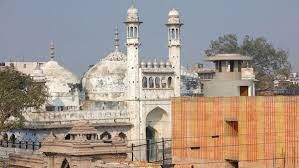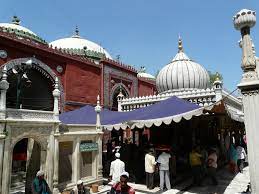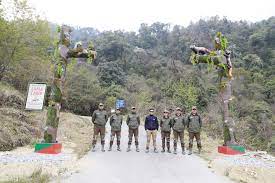Today’s Current Affairs: 29th Jan 2024 for UPSC IAS exams, State PSC exams, SSC CGL, State SSC, RRB, Railways, Banking Exam & IBPS, etc
Table of Contents
Gyanvapi Mosque Survey Report:

The Archaeological Survey of India (ASI) submitted its survey report of the Gyanvapi mosque complex in Varanasi to the district court in December 2022.
- The report concludes that remains of an old Hindu temple existed at the site before the construction of the current mosque structure during Aurangzeb’s reign in the 17th century.
- ASI used ground penetrating radar, differential global positioning systems and scientific dating methods for the survey.
- These advanced technologies provided evidence about underground structures without excavation, exact locations of artefacts and age of very old objects at the site.
- This finding aligns with Persian chronicles and accounts of historians over the years that a Hindu temple adjacent to the Kashi Vishwanath temple was demolished on Aurangzeb’s orders in the 17th century.
- The Persian text Maasir-i-Alamgiri written soon after Aurangzeb’s death in 1707 records his orders in 1669 to governors across India to destroy Hindu temples.
- This included the razing of the Vishwanath temple in Kashi. Historian Jadunath Sarkar’s translation of this text formed key evidence for the ASI report.
- Gyanvapi mosque was constructed in the 1670s or 1680s, incorporating parts of the destroyed Vishwanath temple’s wall.
- This reuse of materials may have been an assertion of Mughal power after Hindu rebels were assisted by local elements.
- While the Gyanvapi mosque was built on the ruins of the old Vishwanath temple, the current Kashi Vishwanath temple near it was built in the 18th century.
- The history of temple desecration but persistent rebuilding reflects the enduring public belief in the religious significance of the site.
Agulhas Long-Billed Lark:

Recent reports suggest that, Agulhas long-billed lark is adapting and surviving despite farming taking over their nesting grounds in South Africa.
- Agulhas long-billed lark Scientific Name: Certhilauda brevirostris.
- It is a small passerine bird.
- The Agulhas long-billed lark is only found in South Africa.
- It builds nests on the ground mainly in Renosterveld fynbos, a type of vegetation filled with grasses and wild spring flowers that is critically endangered by agricultural expansion.
- It is an endemic resident breeder in the Western Cape, South Africa.
- Its restricted range is centred on the Agulhas arable farmlands, from east of the Hottentots-Holland mountain range to Mossel Bay, and occupies a maximum of 15,000 km2 (5,800 sq mi).
- It is long-tailed and has a longish curved bill.
- It has a streaked buff-grey head and back, and the closed wings are grey.
- The underparts are cream-coloured with dark streaking on the breast and flanks.
- Conservation status:-
- IUCN: Near-threatened
Direct Tax-GDP Ratio:

Direct tax-GDP ratio rose to 15-year high in FY-2023.
- Direct tax-to-GDP ratio, rose to a 15-year high of 6.11 per cent in the financial year 2022-23, time-series data released by the Central Board of Direct Taxes (CBDT) under the Ministry of Finance.
- Tax-GDP ratio measures how much tax is collected in relation to the country’s GDP.
- It reflects the share of taxes in the overall output generated in the country.
- The tax-GDP ratio is used to determine how well the government controls a country’s economic resources.
- The tax-to-GDP ratio measures the size of a country’s tax revenue compared to its GDP.
- The higher the tax-to-GDP ratio, the better the country’s financial position.
- The direct tax-to-GDP ratio is the ratio of direct tax collected compared to national gross domestic product (GDP).
- Direct Tax is a tax levied directly on a taxpayer’s income, profit or revenue who pays it to the Government and cannot pass it on to someone else.
- Due to an increase in direct tax revenues, the State can spend on national security, welfare system, public goods, etc.
- The borrowing can be reduced and the fiscal deficit be reduced.
- Higher tax collections increase the capacity of the government to incur expenditure for welfare schemes.
- There will be decreased dependence on indirect taxes which are regressive in nature.
- There will be a decrease in social inequality.
Prime Minister’s Citizen Assistance And Relief In Emergency Situations Fund (PM CARES Fund):

The Delhi High Court recently set aside an order of the Central Information Commission (CIC) directing the Income Tax (IT) department to provide details regarding the tax exemption granted to the PM Cares Fund under the Right to Information Act, 2005.
- PM CARES Fund was created on March 28, 2020, following the COVID-19 pandemic in India.
- It was set up to have a dedicated national fund to deal with any emergency and provide relief to the distressed.
- It has been registered as a Public Charitable Trust.
- The Prime Minister is the ex-officio Chairman of the PM CARES Fund, and the Minister of Defence, Minister of Home Affairs, and Minister of Finance of the Government of India are ex-officio Trustees of the Fund.
- The Chairperson of the Board of Trustees (Prime Minister) shall have the power to nominate three trustees to the Board of Trustees who shall be eminent persons in the fields of research, health, science, social work, law, public administration, and philanthropy.
- Any person appointed a Trustee shall act in a pro bono capacity.
- Objectives is
- To undertake and support relief or assistance of any kind relating to a public health emergency or any other kind of emergency, calamity, or distress, either man-made or natural, including the creation or upgradation of healthcare or pharmaceutical facilities, other necessary infrastructure, funding relevant research, or any other type of support.
- To render financial assistance, provide grants of payments of money, or take such other steps as may be deemed necessary by the Board of Trustees for the affected population.
- To undertake any other activity which is not inconsistent with the above objectives.
Chronic Obstructive Pulmonary Disease : Causes

Health experts list the causes of Chronic Obstructive Pulmonary Disease beyond smoking, including environmental toxins, genetic predispositions, and occupational hazards.
- Chronic Obstructive Pulmonary Disease (COPD) is a chronic inflammatory lung disease that causes obstructed airflow from the lungs.
- There are two main forms of COPD:
- Chronic bronchitis, which involves a long-term cough with mucus.
- Emphysema, which involves damage to the lungs over time.
- Most people with COPD have a combination of both conditions.
- It’s typically caused by long-term exposure to irritating gases or particulate matter, most often from cigarette smoke.
- Tobacco smoking accounts for over 70% of COPD cases in high-income countries.
- In low- and middle-income countries (LMIC), tobacco smoking accounts for 30–40% of COPD cases, and household air pollution is a major risk factor.
- The most common symptoms of COPD are difficulty breathing, chronic cough (sometimes with phlegm) and feeling tired.
- COPD symptoms can get worse quickly.
- These are called flare-ups.
- These usually last for a few days and often require additional medicine.
- People with COPD are at increased risk of developing heart disease, lung cancer, and a variety of other conditions.
- Treatment:
- COPD isn’t curable, but it can get better by not smoking, avoiding air pollution, and getting vaccines.
- It can be treated with medicines, oxygen, and pulmonary rehabilitation.
Free Movement Regime:

The Home Minister recently said the Free Movement Regime (FMR) agreement with Myanmar would be reconsidered to stop border residents from moving into each other’s country without any paperwork.
- Under the FMR, all the hill tribes, whether they are citizens of India or Myanmar, can travel within 16 km on either side of the Indo-Myanmar Border (IMB).
- They can cross the border by producing a border pass with a one-year validity issued by the competent authority and can stay up to two weeks per visit.
- The FMR was implemented in 2018 as part of the Central government’s Act East policy.
- FMR is implemented by both governments for the people living along the IMB.
- This helps locals get more culturally assimilated with trans-border villages through weddings, celebrating common festivals together, and trans-border trade.
- It is a reflection of the physical, ethnic, linguistic, cultural, and fraternal linkages among the trans-border villagers.
French President Recently Visited Hazrat Nizamuddin Aulia Dargah:

The French President recently visited the Hazrat Nizamuddin Aulia Dargah in south Delhi.
- Hazrat Nizamuddin Aulia Dargah is located in Delhi’s Nizamuddin West area.
- It is the mausoleum of the famous Sufi saint, Nizamuddin Auliya (1238-1325 CE).
- It was built in the 14th Century C.E.
- It consists of a square chamber surrounded by verandas, which are pierced by arched openings.
- The dome is ornamented by vertical stripes of black marble and is crowned by a lotus-cresting.
- Inside the dargah complex, one can find the tombs of Nizamuddin Auliya’s saints: Jahanara Begum, Shah Jahan’s favourite daughter, and poet Amir Khusru.
Nizamuddin Auliya:
- Syed Muhammad Nizamuddin Auliya was one of the most famous Sufi saints from the Indian subcontinent region.
- Also known as Hazrat Nizamuddin and Mahbub-e-Ilahi (Beloved of God), he was a Sunni Muslim scholar and Sufi saint of the Chishti Order.
Singchung Bugun Village Community Reserve:

Arunachal Pradesh, at the recently held Republic Day parade, showcased its Singchung Bugun Village Community Reserve, a 17-square-kilometre biodiversity hotspot.
- Singchung Bugun Village Community Reserve is a 17-square-kilometre biodiversity hotspot located in Arunachal Pradesh, around 40 km from the famous Eagle nest Wildlife Sanctuary.
- The reserve was created in 2017 to protect biodiversity in the region.
- It is home to critically endangered species such as the passerine bird Bugun Liocichla (Liocichlabugunorum), which is named after the Buguns community.
- It was one of the first bird species to be discovered in India since the country’s independence in 1947, and it lives only on the Buguns’ community lands.
- The Buguns are an indigenous community with a population of about 2,000 people, spread across 12 villages that are dotted outside the forests of Eagle nest Wildlife Sanctuary.




